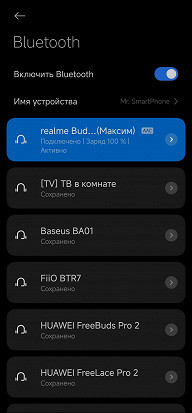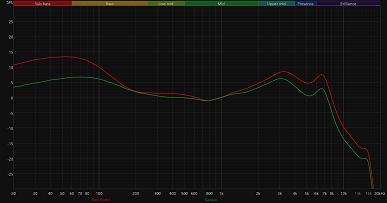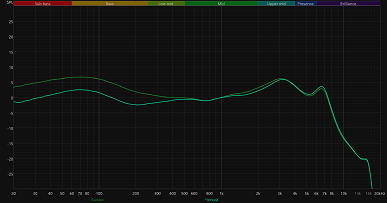A year and a half ago, we tested the Realme Buds T100 TWS headset, which proved itself to be a “budget hit”: for its price, it offered excellent battery life, moisture protection, Google Fast Pair support, and convenient setup software. The sound was also quite decent for this segment.
Over time, it was time for updates, and Realme decided to update the model without changing what was already good. They took a successful device and made the necessary improvements. So, Bluetooth was updated from version 5.3 to 5.4, which increased energy efficiency and increased the battery life of the headphones by an hour, now up to 7 hours. The battery in the case also became larger — from 400 mAh increased to 460 mAh. New colors appeared, and small improvements were made, such as a mesh inside the silicone tips to protect against dirt.
Although budget models often add active noise cancellation, which is rarely effective, Realme developers decided not to follow this trend. Like the previous model, there is no active noise cancellation in Realme Buds T110. All other features remain: 10-mm speakers with titanium coating, customizable control, three sound presets, etc. Now it remains to be seen whether Realme Buds T110 can repeat the success of its predecessor.
Specifications
| Model | Realme Buds T100 | Realme Buds T110 |
|---|---|---|
| Speaker | ∅10 mm | |
| Declared frequency range | 20 Hz — 20 kHz | |
| Connection | Bluetooth 5.3 | Bluetooth 5.4 |
| Codec support | SBC, AAC | |
| Control | touch, Realme Link software | |
| Active Noise Cancellation | No | |
| Multipoint | No | |
| Headphone battery capacity | 40 mAh | |
| Case battery capacity | 400 mAh | 460 mAh |
| Battery life | up to 6 hours | up to 7 o'clock |
| Battery life including charging from the case | up to 28 hours | up to 38 hours |
| Charging connector | USB Type C | |
| Fast charging | 10 minutes for 2 hours of work | |
| Case dimensions | 61×48×28 mm | |
| Earphone dimensions | 22×33×16 mm | |
| Weight of one earphone | 4 g | |
| Weight of the case | 34 g | |
| Water protection | IPX5 | |
| Additionally | gaming mode, noise reduction during calls |
Packaging and assembly
We criticized the previous model a little for the discrepancy between the color of the headphones on the packaging and the actual color of the device. In the new version, this point has been corrected: the headphones on the front side of the box are now blue, like the product itself inside. The box is decorated in the signature yellow color and is made in the style familiar to the brand. The headphones are supplied in a case, which is securely fixed inside with a cardboard tray, so you don’t have to worry about safety during transportation.
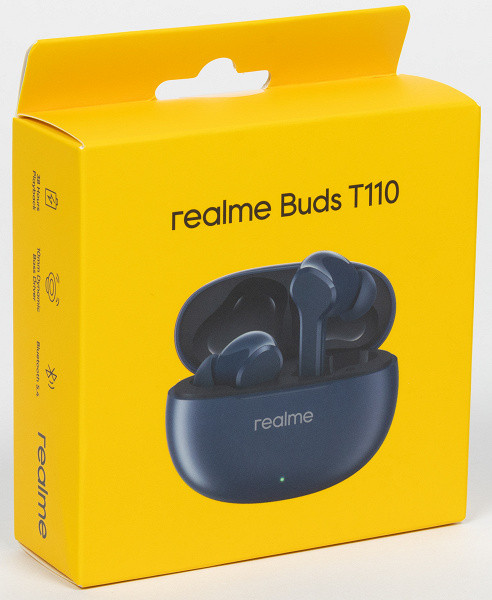
The kit includes the headphones themselves, a charging and carrying case, and two pairs of replaceable silicone tips. The manufacturer did not include a USB cable, which can be considered a plus. In the previous version, it was short — only 15 cm and was practically not used. It is unlikely that modern users have a problem with a lack of charging cables with a USB-C connector, so the lack of a cable will not be a significant loss.
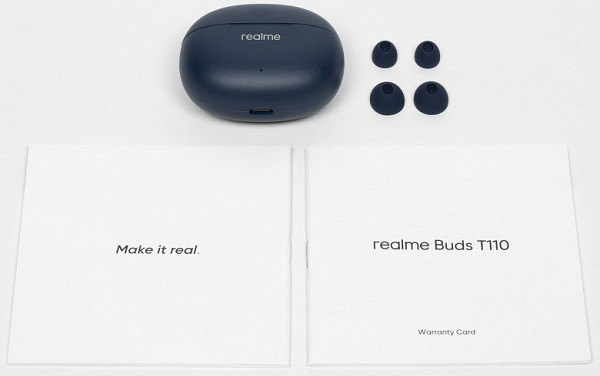
The tips are soft and comfortable, made of pleasant to the touch silicone. Inside there is a mesh that protects the sound tube from dirt getting into it — the Buds T100 did not have it.
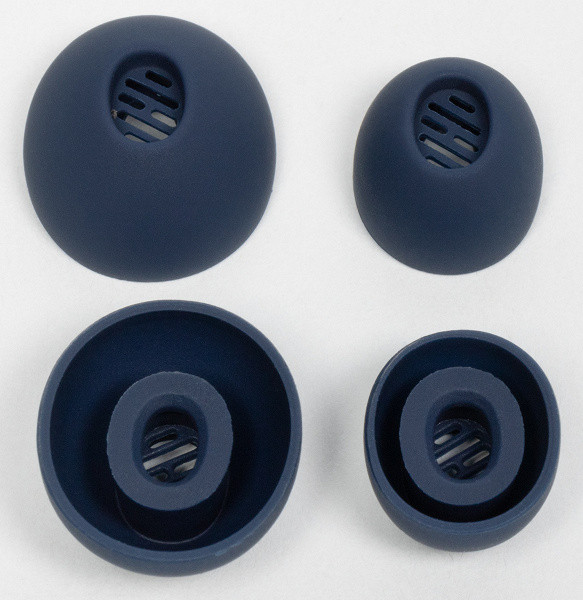
Design and construction
The Realme Buds T110 is available in four colors: black, white, blue, and green, which is a significant improvement over the Buds T100, which was only available in white-gray and black-yellow variants. The form factor of the earbuds remains the same, as can be clearly seen in the photos below.
The shape of the headphones is also the same, all the recognizable elements have been preserved, including the flat “platform” on the outside.


We tested the Realme Buds T100 in white with a glossy case that quickly became covered in fingerprints. Now we have the blue version, which uses matte plastic that is less susceptible to fingerprints. The case is average in size: it fits in a trouser pocket, but not always conveniently.
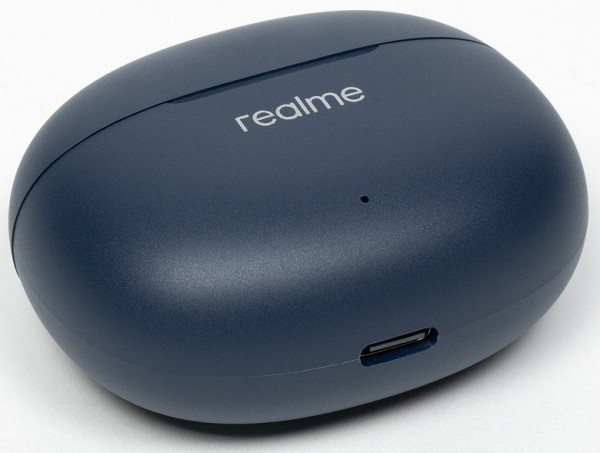
At the bottom of the case is a USB Type C port for charging. There is nothing special else. It is worth noting that the joints of the case halves are visible under bright studio lighting, but under normal conditions they are less noticeable.

The front panel contains the manufacturer's name, a small LED indicator, and a slot for easy opening of the lid. However, this slot is not necessary, since the lid can be easily opened with the finger of one hand holding the base of the case.

There is a hinge on the back panel that allows the lid to be folded back. It opens with medium force, and is held in the closed position by a magnetic fastening.
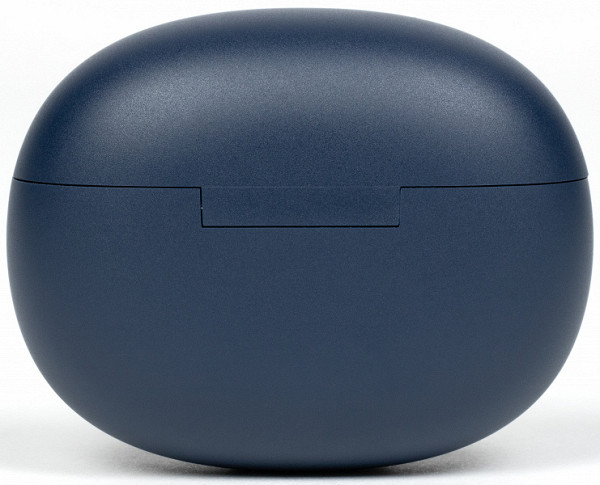
There is no closer, and in the open position the cover is fixed with a light click, although not ideal. It could be better, but overall, the cover does not fall when the case is tilted — which is already good. It is important to remember that this is still a budget headset.
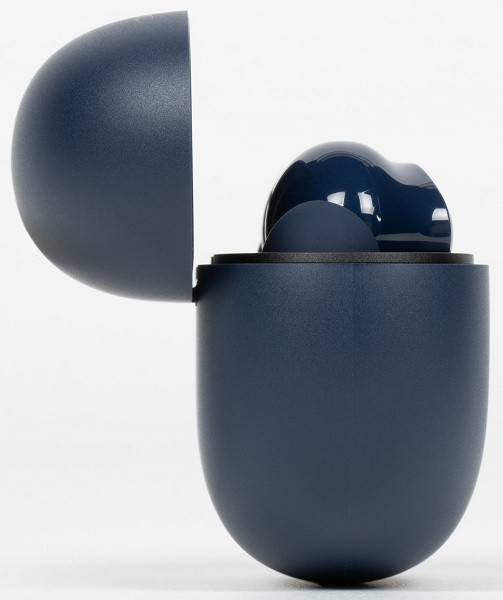
The inside of the case is made of matte plastic, while the headphone slots are made of glossy plastic, which easily attracts fingerprints. The recesses for the headphone «legs» reveal spring-loaded charging contacts.
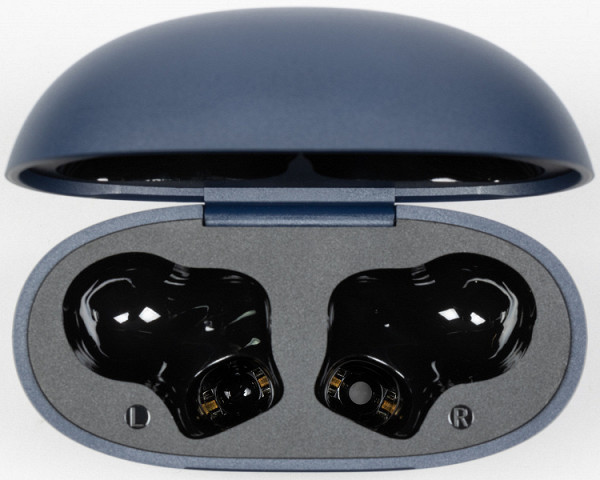
The headphones are securely held inside the case by magnetic fasteners, and removing them is easy — just grab the rounded part and pull up. The top of the headphones has special recesses in the lid, which ensure a secure hold and prevent them from falling out.

The headphones are made of glossy plastic, which easily collects fingerprints and dirt. However, the front surface, which is visible when wearing and where the touch panel is located, is made in a matte coating. This solution helps to avoid frequent contamination in the area most noticeable in everyday use.

The inside of the «legs» have markings for the right and left headphones. It can be a bit difficult to notice them; it's easier to navigate by other signs.

The inside of the case is teardrop-shaped, which should potentially ensure a secure fit for the headphones.
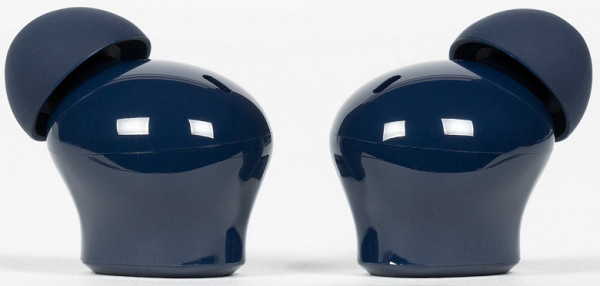
A small protrusion on the back of the teardrop-shaped element provides additional support for the ear cup.

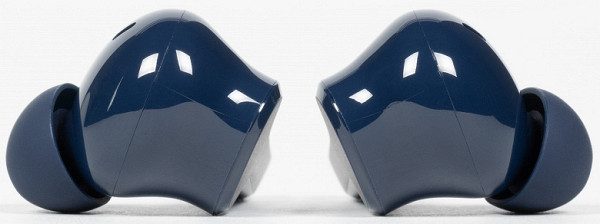
The length of the «sticks» of the headphones is about 18 mm, which helps to avoid snagging on collars, scarves or hair. The sound guide is also short, which minimizes discomfort. The depth of immersion in the ear canal is ensured by the narrowing of the housing of the headphones.


The bottom of the «legs» contains charging contacts and microphones for voice communication, housed in a small «groove.» This design may offer additional protection from wind exposure.
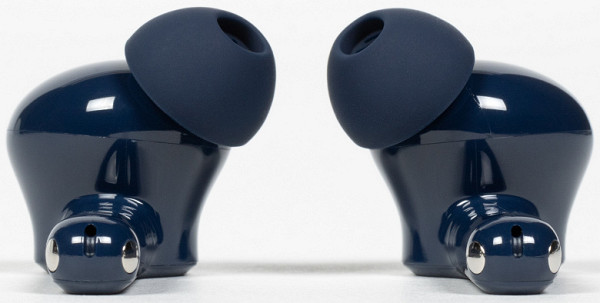
The silicone tips are held in place by a pair of relatively large protrusions at the end of the sound tube. They can be removed and put back in place without much effort.
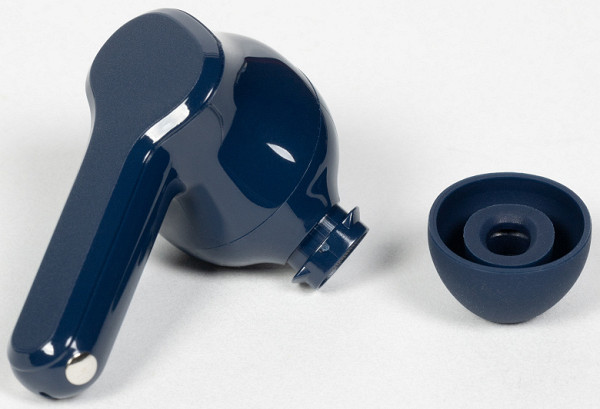
The sound duct opening is covered with a mesh, slightly recessed into the body, which makes it difficult to clean if necessary. However, frequent cleaning is not required, since the silicone tips have their own protective mesh.

There are two holes on the inner surface of the headphones: a round one and a slit-shaped one. The first one is most likely intended to compensate for the pressure when the dynamic driver is working, and the second one may hide the microphone of the noise-canceling system or be used to improve the reproduction of low frequencies.
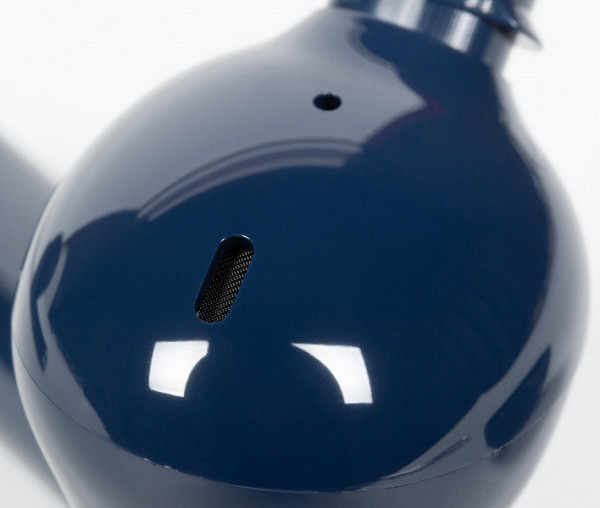
Connection and setup
Google Fast Pair is supported again, so pairing the headset with Android devices is very quick and easy. After opening the case lid, an invitation to connect appears on the screen. Just agree, wait a few more seconds — and the connection is complete.
There is no support for simultaneous connection to several devices (multipoint), as with the Buds T100. For a budget headset, this is understandable, but it would be nice to see this feature in the updated model. The list of supported codecs, which we checked with Bluetooth Tweaker, includes the standard SBC and AAC. For a device in this price segment, they are enough.

Although the SBC and AAC codecs are good, their settings in this model raise questions. The maximum Bitpool parameter for SBC is limited to 38, while the High Quality profile recommends a value of 51. For AAC, the upper bitrate limit is set at 131 kbps, although many devices use 256 kbps. This is probably done to ensure connection stability.
Nevertheless, the Realme Buds T110 has excellent communication quality: the headphones work stably even in conditions of increased radio interference. Sound lag in games and videos is not noticeable, and a special mode is provided to minimize lags, available only for Android devices.
Management and software
To manage the advanced features of the headphones, it is recommended to install the Realme Link app. Connected headphones are automatically added to the app and displayed on the main page. You just need to click on them, read the quick guide and start using them. On the main screen of the app, you can monitor the battery level of the headphones and the case (if it is open).
Almost in the center of the application screen is a module for activating one of three sound modes, which we will discuss in more detail in the next chapter. You can also turn on the volume increase function here, while the application warns that high volume levels can damage your hearing. Below is a switch for activating the gaming mode, which helps eliminate «desyncs» between sound and image when watching videos and playing games.
Control is via touch panels located on the flat outer part of the headphones. We are usually wary of sensors on budget devices, as they often work poorly and make you yearn for physical buttons. However, in this case, the sensors work well: there are no false positives, all touches are registered correctly.

The default control profile is fairly straightforward and logical, but it wouldn't hurt to customize the sensors to your preferences, especially considering that this is possible with such an inexpensive headset. Single tap is disabled to avoid accidental triggering.
Dual, triple and long-press touchpads can be customized for each earbud individually, which is rare for budget models. Volume control is also available. Long-pressing both panels activates the gaming mode, which can only be turned on or off, but not customized.
Holding both touchpads simultaneously for 5 seconds activates pairing mode, and holding them for longer will reset the device to factory settings.
Exploitation
The Realme Buds T110 fit securely and comfortably, just like their predecessors. The sound tube does not penetrate deep into the ear canal, and the rounded part rests firmly on the auricle. The earphones do not shift even during intense gym workouts, such as jumping rope or incline bench exercises. They stay in place even during vigorous movements, after which many earphones require adjustment.

In addition, the headphones have IPX5 water resistance, which means they are protected from directed jets of water and rain. They are suitable for sports and active activities: comfortable, durable and inexpensive enough to not worry about possible loss.
Microphones for voice communication
The manufacturer does not provide much information about the microphones in the headset, focusing on the presence of «intelligent noise reduction» during calls. This makes the process of testing them interesting.
To measure the frequency response of the microphones, we use a specially prepared room and a monitor acoustic system that reproduces a sweep tone. Since the frequency response of the speakers is not uniform, we first obtain its graph using a calibrated measurement microphone. Then we create a correction profile to compensate for the acoustic features. After that, we record the signal using the microphone under test, placed in the same place as the measurement one. The resulting graph is corrected using a previously created profile, which allows us to obtain an accurate frequency response of the microphone under test.
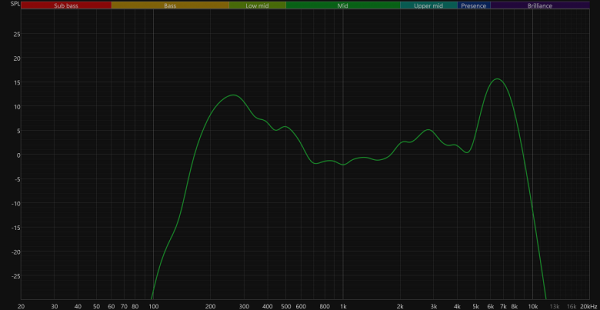
The voice of an adult male usually has a fundamental frequency of 85 to 155 Hz, and for women — from 165 to 255 Hz. However, frequencies from 300 to 3400 Hz are mainly used for voice transmission, since this is the range where the formants responsible for speech intelligibility are located. Frequencies below 300 Hz are usually cut off to avoid unwanted sounds, such as engine hum or low-frequency noise.
The microphone in the Realme Buds T110 is configured quite unusually, but for a budget headset, its characteristics can be assessed as good. An increase in the 300 Hz region can add a subjective sense of voice transmission quality, but an emphasis on the lower middle can lead to excessive «boom», which does not always contribute to speech intelligibility. Probably, to compensate for this feature, the developers focused on frequencies of 5-8 kHz, which are responsible for the clarity and readability of speech.
The voice is recorded a little muffled, but overall intelligible. The emphasis on the high-frequency range improves intelligibility, but makes sibilants less pleasant. In general, communication via Realme Buds T110 is possible and is not inferior in quality to many more expensive devices.
The emphasis on the low frequencies has become more restrained, perhaps to compensate for the «gaps» in the operation of noise reduction. As a result, the voice sounds less natural, but quite intelligible. External noises are almost inaudible, although sometimes car horns can break through. There is also a barely noticeable effect of «doubling» the voice. In general, the recording clearly demonstrates that a well-recorded voice is perceived even in the presence of background noise.
Autonomy and charging
The battery of the Realme Buds T110 remains the same in capacity — 40 mAh, like the Buds T100 model. However, the declared operating time has increased from 6 to 7 hours, which is likely due to the improved energy efficiency of Bluetooth 5.4. This data is based on tests conducted in the manufacturer's lab, so we will have to check whether the headphones really last the declared 7 hours in our tests.
To check the operating time of wireless headphones, we use the following methodology. The safe sound pressure level when listening to music is 75 dB, but most users prefer a level of 90-100 dB. We play white noise with an SPL level of about 95 dB and record the signal from the measuring stand to determine how long the headphones will work.

The headphones discharge almost evenly, but the right one works a little less than the left one. Since very few people use headsets in mono mode, usually when one earphone is disconnected, both are put into the charging case. Therefore, when assessing the average battery life, we will focus on the earphone with the shorter operating time. We will collect all the results in a table.
| Left earphone | Right earphone | |
|---|---|---|
| Test #1 | 6 hours 51 minutes | 6 hours 56 minutes |
| Test #2 | 6 hours 48 minutes | 7 hours 3 minutes |
| Average | 6 hours 50 minutes | 6 hours 59 minutes |
The stated 7 hours of headphone operation are almost completely justified, and by reducing the volume you can get even more time. The battery of the case has also been increased and is now able to fully charge the headphones up to 5 times, with a small reserve. This provides at least the stated 38 hours of battery life, taking into account recharging from the case, which is enough for a week of active use.
According to the instructions, fast charging allows the headphones to work for up to 2 hours after 10 minutes in the case. In practice, we observed a little less — about 1.5 hours. This is a little disappointing, but still enough for comfortable use. In the event of a quick discharge of the headphones, you will only need a short break to charge them to ensure operation during the trip, walk or workout. In general, the risk of being left without music and communication is minimal — you just need to remember to put the headphones in the case from time to time and periodically charge the case itself.
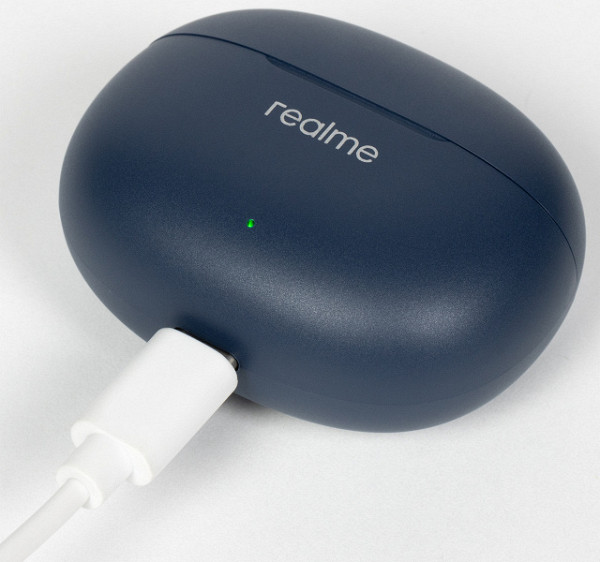
Sound and frequency response measurements
The description of the headphones promises “titanium-coated composite dome membranes” capable of delivering “crazy bass.” This may attract lovers of deep bass, but other users may be a little wary. However, as numerous positive reviews of the Realme Buds T100 show, many listeners will appreciate the spectacular bass, which is indeed present here. It is a little boomy, but sounds harmonious, although it slightly overshadows the mids. The mids are delivered quite smoothly for budget headphones, which is an achievement in itself. High frequencies are slightly emphasized to improve readability, but without the typical problems of this range. In general, the sound is suitable for background — be it a workout, a trip to the office, a walk or a run. To illustrate these characteristics, we provide a frequency response graph.
Please note that the frequency response graphs are intended only to demonstrate the main features of the headphones' sound and you should not judge the quality of the model based on them alone. Each listener's actual experience may vary depending on a number of factors, including individual hearing characteristics and the silicone tips used.
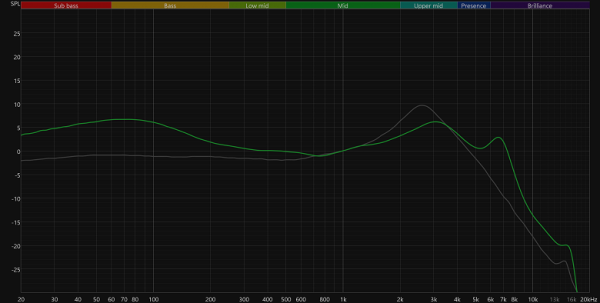
The frequency response graph is presented against the background of the IDF (IEM diffuse field compensation) curve provided by the test rig manufacturer. The purpose of this curve is to compensate for resonance effects in the simulated ear canal and the specifics of the equipment, creating a “sound profile” that most accurately reflects the listener’s perception of the headphones. This can be considered a device-specific version of the so-called “Harman curve” developed by the Harman International team led by Dr. Sean Olive. Based on this curve, the frequency response graph can be adjusted.
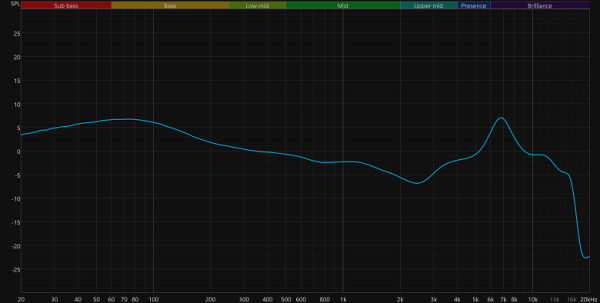
In this form, the graph most accurately reflects the subjective impressions of listening: a noticeable boost in bass, which slightly distorts the generally flat middle. It should be taken into account that the perception of low frequencies depends on the tightness of the fit of the headphones — the tighter the silicone tips fit the walls of the ear canal, the more bass will be felt. If there is too much bass, try changing the tips to smaller ones — this can also make the fit of the headphones more comfortable. High frequencies are slightly emphasized, although on the graph the peak looks more noticeable than it is felt when listening. Now let's compare two models — Realme Buds T110 and Buds T100. It is clear that these are almost the same headphones. Small differences in the graphs are probably due to the fact that the headphones cannot always be placed in the measuring stand exactly the same way, as well as with minor changes in the shape of the silicone tips.

The sharp drop in high frequencies is due to the implementation of the AAC codec on Android devices, which we have already mentioned more than once. To test this assumption, you can switch to the SBC codec, and, as you can see, the high frequencies return to their place. However, the question of how important frequencies above 16 kHz are for everyday listening on the go remains open for a separate discussion.
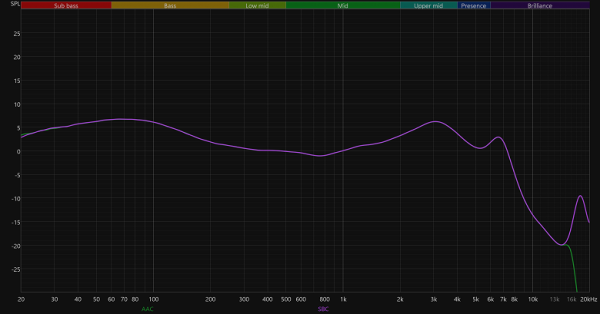
The sound profiles live up to their names. The Bass Boost mode further emphasizes the already accentuated bass, which is suitable for true lovers of deep low frequencies. The Clear mode improves speech intelligibility and is ideal for watching conversational videos or listening to podcasts. It significantly reduces the level of low frequencies, which can be useful for those who prefer less pronounced bass in music. However, at the same time, the lower midrange is also lost, which makes the sound somewhat “dull” and unclear. Hopefully, in the future, a mode will appear that will be able to soften the emphasis on low frequencies without such side effects.
Results
The developers of Realme Buds T110 have updated the popular model, retaining all the key advantages. The headset still supports Google Fast Pair, is waterproof and offers high-quality software for customization. The sound remains bassy and even a little better than other budget devices. Autonomy has been improved, the battery capacity in the case has been increased, new design colors and mesh on the silicone tips have been added. The only disappointment is the preservation of the same number of sound profiles, which are not quite suitable for music, and the lack of multipoint support. The cost remained at about $ 30, which makes Realme Buds T110 an excellent choice for everyday use if active noise cancellation is not a priority. Despite the increased competition in this segment, Realme Buds T110 still remains a strong competitor.






